Are you a Quiet Speculation member?
If not, now is a perfect time to join up! Our powerful tools, breaking-news analysis, and exclusive Discord channel will make sure you stay up to date and ahead of the curve.
Looking over the Top 32 lists from last week's Modern Open, I realized I hadn't studied Wizards' 5-0 lists in some time. My wake-up call? Andrew Schneider's deck, which revolved around a Guilds of Ravnica card that immediately piqued my interest when it was spoiled six weeks ago: Arclight Phoenix. A careful review of each unchecked 5-0 document revealed that Andrew's list was no fluke; Phoenix has been tearing up the online metagame, excelling alongside a wildly varying cast of accompanying characters. Today, we'll revisit Phoenix's applications in Modern and explore those winning builds.
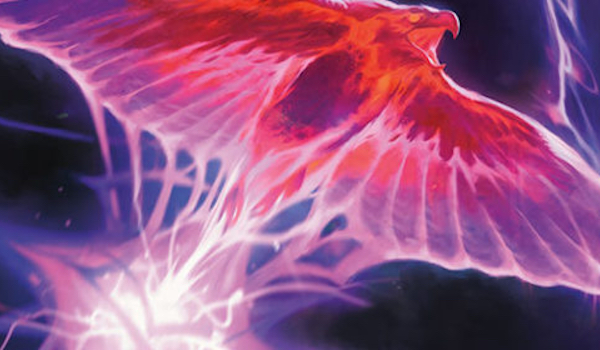
Strategic Curving
Critical to Arclight Phoenix's Modern success is a new idea I've been working on called strategic curving. Most Magic players are aware of the mana curve, or "the application of mana optimization theory to deck construction." A deck full of two-drops won't have anything to do until turn two, while a deck with a healthy mix of one-, two, and three-drops can make land drops each turn while consistently spending all its available mana. That said, the deck with exclusively two-drops is all but guaranteed to have a play on turn two, while the deck with the mix is not.
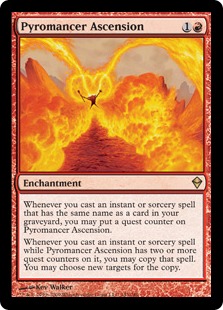 Strategic curving follows the same principle, but deals with limitations placed on cards other than their mana cost. Take, for instance, Thing in the Ice and Pyromancer's Ascension. These cards occupy the same notch on the strategic curve: pilots need to deploy them early and power them up with instants and sorceries cast after the fact. Until "turned on," the cards do nothing; if bounced or drawn late, they rot on the battlefield. Running full sets of both cards helps ensure players have one to cast on turn two, but also locks players into that slot on the strategic curve.
Strategic curving follows the same principle, but deals with limitations placed on cards other than their mana cost. Take, for instance, Thing in the Ice and Pyromancer's Ascension. These cards occupy the same notch on the strategic curve: pilots need to deploy them early and power them up with instants and sorceries cast after the fact. Until "turned on," the cards do nothing; if bounced or drawn late, they rot on the battlefield. Running full sets of both cards helps ensure players have one to cast on turn two, but also locks players into that slot on the strategic curve.
To counteract this effect, deckbuilders look to cards that utilize similar resources in the hopes of retaining synergy, but that thrive under different conditions to provide flexibility. One common yang to the ying of Thing in the Ice is Bedlam Reveler. Unlike Thing and Ascension, Reveler can't be cast on turn two. Rather, its job is to come down late in the game, blowing other topdecks out of the water. In a deck that casts lots of instants and sorceries, both types of card have their place, but each dominates its own part of the game.
 In the middle of this see-saw rest cards like Monastery Swiftspear, Kiln Fiend, Young Pyromancer, and Arclight Phoenix. These cards don't have as steep a late-game requirement as Bedlam Reveler, but still provide value without a full grip of instants and sorceries at the ready; the value they generate (be it damage or tokens) also lasts if removed, unlike Ascension and Thing (counters irrelevant with their permanents absent from the battlefield).
In the middle of this see-saw rest cards like Monastery Swiftspear, Kiln Fiend, Young Pyromancer, and Arclight Phoenix. These cards don't have as steep a late-game requirement as Bedlam Reveler, but still provide value without a full grip of instants and sorceries at the ready; the value they generate (be it damage or tokens) also lasts if removed, unlike Ascension and Thing (counters irrelevant with their permanents absent from the battlefield).
A properly-balanced strategic curve mixes these cards in such a way that it has impactful plays throughout the game and rarely chokes on too many cards that occupy the same game space. The following lists occupy varying sides of that tightrope, their decisions crystallized by their creature counts.
Mono-Red
Arclight Phoenix decks live and die by their monsters. In total, I found seven distinct threat suites among dedicated Phoenix decks, four of which employ only a single color. We'll start with those.
Arclight Red, by Andrew Schneider (30th, SCG Charlotte)
Andrew's aforementioned build warps a reach-heavy Burn shell around Phoenix, and is a go-to online. Monastery Swiftspear is the primary carry-over from actual Burn, but the deck still seeks to string together 20 damage before opponents can get their bearings.
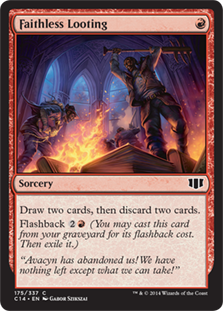 Strategically, Arclight Red lords two things over Burn: impressive bodies and incidental value. A 3/2 flying and a 3/4 prowess let this deck dominate the red zone in ways Burn can only dream of. And native to the apparent Phoenix core is Faithless Looting, which not only turbo-charges Monastery Swiftspear by turning lands into business, but effectively draws players cards when pitching Fiery Temper or Phoenix itself. These dimensions allow the deck to function on fewer cards than Burn, a deck that assembles 20 damage more traditionally: by just having it.
Strategically, Arclight Red lords two things over Burn: impressive bodies and incidental value. A 3/2 flying and a 3/4 prowess let this deck dominate the red zone in ways Burn can only dream of. And native to the apparent Phoenix core is Faithless Looting, which not only turbo-charges Monastery Swiftspear by turning lands into business, but effectively draws players cards when pitching Fiery Temper or Phoenix itself. These dimensions allow the deck to function on fewer cards than Burn, a deck that assembles 20 damage more traditionally: by just having it.
Burn still has its benefits over Arclight Red, though. It's more consistent, for one. While Looting helps Arclight on this front, it doesn't come close to matching the streamlined core of the Burn deck, which has time again proven itself as one of Modern's most reliable machines. Burn also doesn't have to worry about protecting its synergies from random hosers like Scavenging Ooze.
On that synergy note, not needing its cards to work together beyond just dealing damage lets Burn dedicate its slots to on-plan role-players like Lightning Helix and Skullcrack rather than must-include engine greasers like Manamorphose. Too much of the latter can soften the deck to other format checks, such as Thalia, Guardian of Thraben and even Eidolon of the Great Revel in the pseudo-mirror.
Runaway Red, by ARCHANGELIC76 (5-0)
This deck replaces Swiftspear with Runaway Steam-Kin, and becomes more combo-focused as a result. Steam-Kin can prove slow in the early turns, when mana's tight, but untapping with it lets players embark on a card-sifting journey to damage land, chaining together Risk Factors and Fiery Tempers 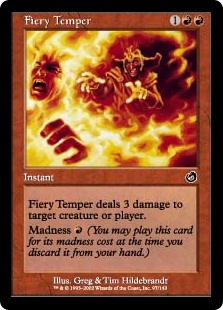 while digging through the deck with Faithless Looting. That journey's sponsored by the Elemental, which first made Modern headlines amidst promises of first-turn kills, but now seems better-poised as a low-investment value engine.
while digging through the deck with Faithless Looting. That journey's sponsored by the Elemental, which first made Modern headlines amidst promises of first-turn kills, but now seems better-poised as a low-investment value engine.
ARCHANGELIC76's build goes all-in on the combo dimension, maxing out on two-mana rituals as well as Manamorphose. It counts on Reveler, as well as Looting and Factor in the grave, to serve as outlets for all the mana provided on critical turns. Alongside these aims, Phoenix acts as a sort of Plan B, front-loading damage and diverting opponents' resources while pilots set up a big turn.
The combo version seems better than the Burn version against one-shot hate such as Feed the Clan. Its big turns overwhelm that kind of disruption at the price of being more synergy-based, and therefore softer to targeted discard and permission.
Runaway Red, by NEMATIC (23rd, Modern Challenge #11659813)
Up next is a list featuring Reveler, Swiftspear, and Steam-Kin, bringing the creature count up from 12 to 16. To make room for the newcomers, NEMATIC cut a little bit from each previous list, settling on just the four best rituals and Lava Spikes, respectively. By divesting his plans, NEMATIC increases both his resilience to focused hate and his dependance on the deck to provide him with the right pieces at the right times. In other words, he's accepted some degree of tension to have access to aspects of both shells throughout the tournament.
Bomat Kin, by SUPERRADJOE (5-0)
SUPERRADJOE also runs 16 creatures, but Monastery Swiftspear gets the axe here for Bomat Courier. Gone too is Lava Spike, replaced by Tormenting Voice and more rituals to help with the Steam-Kin combo plan. A  beefy Bomat can immediately draw pilots into big turns, even after combat; that said, Bomat could just as well draw a more traditional Burn deck into enough Lava Spikes to close out the game.
beefy Bomat can immediately draw pilots into big turns, even after combat; that said, Bomat could just as well draw a more traditional Burn deck into enough Lava Spikes to close out the game.
On the Construct itself, I explored its applications in Modern earlier this year, and found it especially potent against decks without blockers. These opponents are incentivized to remove Bomat as quickly as possible, which draws heat away from more critical creatures (for me, Tarmogoyf; for Joe, Steam-Kin). Should it live, Bomat rewards players with reach in their decks. Despite this reward, I'm not totally sold on Bomat in a Phoenix shell, for now preferring creatures that directly contribute to its gameplans (i.e. Swiftspear).
Blue-Red
Arclight Phoenix has also found its way into ostensibly fairer decks, or ones looking to do most of their damage through combat. These shells tend to splash blue for additional filtering and the occasional juicy creature.
Phoenix Thing, by W0RDJUICEBOX (5-0)
We'll begin with the simplest of the UR lists. W0RDJUICEBOX's plays a paltry 12 creatures, but boasts a serious upgrade to Tormenting Voice in Chart a Course. Chart keeps the cards flowing and even provides players with hard card advantage, an important benefit over mere filtering with Looting in 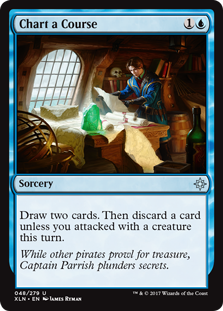 the picture. Discarding a card with Chart can even prove preferable when it comes to pumping out Bedlam Reveler or casting Fiery Temper, giving the sorcery more play.
the picture. Discarding a card with Chart can even prove preferable when it comes to pumping out Bedlam Reveler or casting Fiery Temper, giving the sorcery more play.
Thing in the Ice packs a wallop against removal-light creature strategies, taking the pressure off Bolt effects when it comes to disrupting synergies and combos. Those burn spells can instead by pointed at opponents' heads, helping a swing from Awoken Horror turn lethal. As usual, Phoenix also contributes to the damage count, but its role as a recursive flying blocker is underlined in this build. Alongside Thing, the UR deck has more reversibility than the mono-red builds we've seen so far.
Electro Steam, by MENTALMISSTEP (5-0)
If you thought Chart a Course was strong at two mana, wait till you see it at one! My own attempts at combining Baral or Electromancer with Chart in a tempo shell failed, but MENTALMISSTEP appears to have achieved that dream for me. This deck features a lot of pieces that don't quite fit together all the time, but occasionally produce impressive results. Things tend to snowball the more of each creature is in play. In testing, my Electromancer enabled a combo kill with Steam-Kin in which I chained multiple Lootings and Risk Factors from the grave to draw into 12 points of reach. I also attacked with a 7/8 Swiftspear!
This deck is alone in excluding Bedlam Reveler, as the Horror has no direct synergy with Electromancer. I think it could stand to abuse the graveyard a little more.
Crackling Kiln, by BLOOPBLOP (5-0)
Joining the slower Thing in the Ice here is Kiln Fiend, an aggro-combo standby that steals games against uninteractive opponents. Blue spells compliment Fiend well, especially Thought Scour 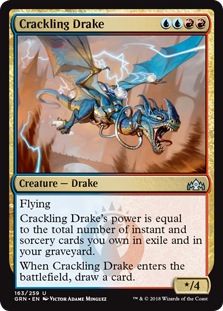 and Stubborn Denial—the former can be cast after no blocks are declared while Denial stays up to protect the Elemental, and the latter immediately turns on ferocious, as it does with an almost-flipped Thing.
and Stubborn Denial—the former can be cast after no blocks are declared while Denial stays up to protect the Elemental, and the latter immediately turns on ferocious, as it does with an almost-flipped Thing.
This build is more reversible than any of the others, both thanks to its counterspells and its diverse collection of creatures. Thing and Phoenix can play proactive and defensive roles, as discussed, but complimenting the all-in Kiln Fiend plan is another pet card of mine from Guilds, Crackling Drake. Drake may be one-of, but the deck nonetheless seems built around it. Scour and Briefing retain relevance in multiples thanks to Drake's presence, which can be doubled after siding against more disruptive decks.
Born Again
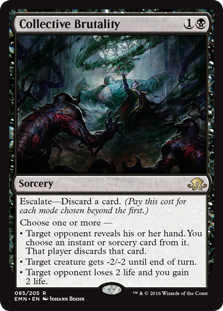 I've come away with a couple conclusions from this onslaught of Phoenix decks. For one, the card clearly has a place in Modern, both as one worthy of building around and perhaps as a role-player for other strategies (I even spotted a set in Hollow One). Second, I'm convinced there's an ideal threat combination for the Phoenix decks, but that combination has yet to be settled on by the community at large. I'd be surprised if we didn't see a black shell emerge in the near future, as Collective Brutality, Fatal Push, and targeted discard all seem like fine ways to support the 3/2. But then, they might not be proactive enough.
I've come away with a couple conclusions from this onslaught of Phoenix decks. For one, the card clearly has a place in Modern, both as one worthy of building around and perhaps as a role-player for other strategies (I even spotted a set in Hollow One). Second, I'm convinced there's an ideal threat combination for the Phoenix decks, but that combination has yet to be settled on by the community at large. I'd be surprised if we didn't see a black shell emerge in the near future, as Collective Brutality, Fatal Push, and targeted discard all seem like fine ways to support the 3/2. But then, they might not be proactive enough.
In any case, I can't wait to see what Phoenix devotees have in store for us in the coming months! Which Guilds cards have you been experimenting with?





Is it possible that in a squadron hawk-y kind of way, this phoenix may end up being a resilient, repeatable threat in an otherwise creatureless deck?
It’s also, potentially, a decent card when combined with powerful equipment due to its resiliency. Oh hey there basilisk collar =)
I think it’s possible. As outlined in the article, it seems to have merits as a role-player, not least for its flexibility in combat—I’ve read that Phoenix’s defensive capabilities greatly impressed certain players, who would chain together cantrips each turn to find removal or Reveler and end up with a constant blocker for Mantis Riders and the like for their trouble. Less excited about the prospect of equipment, which has tension with Phoenix’s conditions and gives opponents more value out of their kill spells.